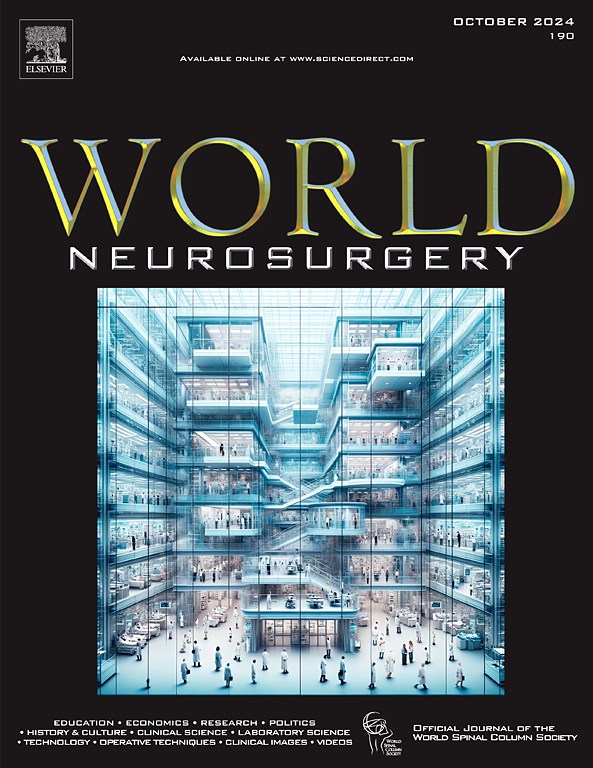如何选择颈椎前路椎间盘切除术融合后椎笼沉降的测量方法?
IF 2.1
4区 医学
Q3 CLINICAL NEUROLOGY
引用次数: 0
摘要
背景:从颈椎前路椎间盘切除术和融合术(ACDF)后的x线片测量椎笼沉降的方法尚未标准化,通常分为三种方法。这些方法的可靠性和临床相关性尚未完全阐明。本研究旨在评估三种基于x线照片的测量ACDF后笼沉降的方法,并确定最可靠的方法。方法:对颈椎侧位片完整、清晰的患者进行沉陷评估。分别用网箱迁移至端板高度(ΔCMH)、盘空间高度变化(ΔDH)和中段高度变化(ΔMSH)来表示网箱沉降。比较了三种测量方法的差异。计算类间相关系数(ICCs)来评估三种测量方法的可靠性。采用Spearman相关系数评价这三种方法的临床相关性。结果:共纳入105例142级患者。ΔDH方法与ΔCMH/ΔMSH方法之间存在显著差异,而ΔCMH方法与ΔMSH方法之间无显著差异。所有方法都具有良好的可靠性,其中ΔMSH方法显示出最高的观察者内部和观察者之间的icc。ΔMSH法测量的沉降值与临床结果的相关性较好,而ΔDH和ΔCMH法测量的沉降值与临床结果的相关性较差。结论:ΔDH方法与ΔCMH/ΔMSH方法在同一研究中不可互换。我们推荐ΔMSH测量沉降的方法,因为它的可靠性和临床相关性相对较好。本文章由计算机程序翻译,如有差异,请以英文原文为准。
How to Choose the Measurement Methods for Cage Subsidence Following Anterior Cervical Discectomy and Fusion?
Background
The methods for measuring cage subsidence from radiographs after anterior cervical discectomy and fusion were not standardized and are typically categorized into 3 approaches. The reliability and clinical correlation of these methods have not been fully elucidated. This study aims to evaluate 3 methods based on radiographs for measuring cage subsidence following anterior cervical discectomy and fusion and identify the most reliable one.
Methods
The patients with complete and clear lateral cervical radiographs were included in this study to assess subsidence. The cage migration into endplate height (ΔCMH), change in disc space height (ΔDH), and change in middle segment height (ΔMSH) were separately used to represent cage subsidence. The differences between the 3 measurement methods were compared. Interclass correlation coefficients were calculated to assess the reliability of the 3 measurement methods. Spearman's correlation coefficient was used to assess the clinical relevance of these 3 methods.
Results
A total of 105 patients with 142 levels were included in the study. There were significant differences between the ΔDH and the ΔCMH/ΔMSH methods, but not between the ΔCMH and ΔMSH methods. All methods presented good reliability, with the ΔMSH method showing the highest intra- and inter-observer interclass correlation coefficients. The subsidence values measured by ΔMSH showed good correlation with clinical outcomes, while those measured by the ΔDH and ΔCMH methods demonstrated poor clinical correlation.
Conclusions
The ΔDH method and the ΔCMH/ΔMSH method are not interchangeable within a single study. We recommend the ΔMSH method for measuring subsidence due to its relatively better reliability and clinical correlation.
求助全文
通过发布文献求助,成功后即可免费获取论文全文。
去求助
来源期刊

World neurosurgery
CLINICAL NEUROLOGY-SURGERY
CiteScore
3.90
自引率
15.00%
发文量
1765
审稿时长
47 days
期刊介绍:
World Neurosurgery has an open access mirror journal World Neurosurgery: X, sharing the same aims and scope, editorial team, submission system and rigorous peer review.
The journal''s mission is to:
-To provide a first-class international forum and a 2-way conduit for dialogue that is relevant to neurosurgeons and providers who care for neurosurgery patients. The categories of the exchanged information include clinical and basic science, as well as global information that provide social, political, educational, economic, cultural or societal insights and knowledge that are of significance and relevance to worldwide neurosurgery patient care.
-To act as a primary intellectual catalyst for the stimulation of creativity, the creation of new knowledge, and the enhancement of quality neurosurgical care worldwide.
-To provide a forum for communication that enriches the lives of all neurosurgeons and their colleagues; and, in so doing, enriches the lives of their patients.
Topics to be addressed in World Neurosurgery include: EDUCATION, ECONOMICS, RESEARCH, POLITICS, HISTORY, CULTURE, CLINICAL SCIENCE, LABORATORY SCIENCE, TECHNOLOGY, OPERATIVE TECHNIQUES, CLINICAL IMAGES, VIDEOS
 求助内容:
求助内容: 应助结果提醒方式:
应助结果提醒方式:


